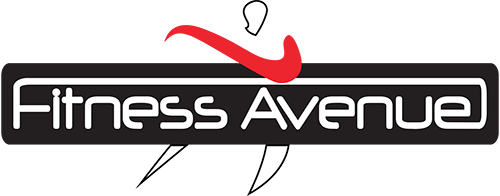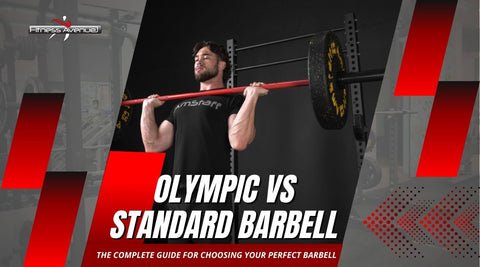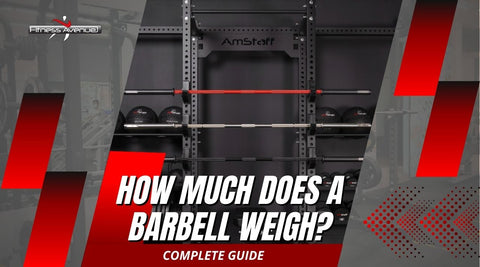When you're setting up a home gym or upgrading your lifting equipment, the choice between Olympic and standard barbells becomes one of your most crucial decisions. This fundamental equipment choice will influence everything from your exercise selection and progression potential to your long-term training satisfaction and safety.
While both barbell types serve strength training purposes, they represent completely different equipment ecosystems with distinct advantages, limitations, and compatibility requirements that can significantly impact your fitness journey.
Olympic vs Standard Barbell Comparison Table
|
Feature |
Olympic Barbell |
Standard Barbell |
|---|---|---|
|
Sleeve Diameter |
2 inches (50mm) |
1 inch (25mm) |
|
Total Length |
7 feet 2.6 inches (86.6") |
4-6 feet variable |
|
Weight Capacity |
700-1,500+ lbs |
200-300 lbs |
|
Men's: 45 lbs, Women's: 33 lbs |
15-25 lbs variable |
|
|
Rotating Sleeves |
Yes (bearings/bushings) |
No (fixed sleeves) |
|
Tensile Strength |
165,000-205,000+ PSI |
120,000-150,000 PSI |
|
Price Range |
$150-$800+ |
$50-$150 |
|
Plate Compatibility |
Olympic plates only |
Standard plates only |
|
Best For |
Serious training, Olympic lifts |
Beginners, limited budgets |
Key Differences Between Olympic and Standard Barbells
Bar Diameter and Grip

The most obvious distinction is found in the sleeve diameter. Olympic barbells feature standardized 2-inch (50mm) sleeves that accommodate Olympic weight plates, while standard barbells use 1-inch (25mm) sleeves throughout their entire length. This dimensional difference creates completely separate equipment ecosystems - you cannot mix Olympic plates with standard barbells or vice versa without adapters.
The shaft diameter also varies significantly between these barbell types. Olympic barbells typically feature shaft diameters of 28-29mm for men's bars and 25mm for women's bars, providing optimal grip characteristics for different hand sizes and training applications. Standard barbells maintain the same 1-inch diameter throughout, which can compromise grip comfort during extended training sessions.
Sleeve Design
Olympic barbells feature sophisticated rotating sleeve mechanisms that utilize either bronze bushings or precision bearings. This allows the weight plates to spin independently of the barbell shaft, reducing stress on the wrist and elbow during dynamic movements such as the clean and jerk or snatch. The smooth rotation proves essential for Olympic lifting movements where the bar must turn in your hands during different lifting phases.
Standard barbells feature fixed sleeves that rotate as one unit with the entire bar. While this simplified design reduces manufacturing costs, it creates additional joint stress during any exercises involving bar rotation and eliminates many dynamic lifting movements from your exercise repertoire.
Weight Capacity
The most significant performance difference may be related to weight capacity limitations. Olympic barbells typically support 700-1,500+ pounds depending on their construction quality and intended use. Entry-level Olympic bars handle 700+ pounds, while premium competition bars exceed 1,500 pounds. This substantial capacity accommodates serious strength development and provides safety margins for maximum weight efforts.
Standard barbells generally max out at 200-300 pounds before risking permanent deformation or structural failure. This limitation quickly becomes problematic as your strength develops, particularly for compound movements like deadlifts and squats, where intermediate lifters routinely exceed these thresholds.
Durability and Material Quality
Olympic barbells are made from high-tensile strength steel with ratings between 165,000 and 205,000+ PSI, ensuring exceptional durability and consistent performance over the course of decades of use. The superior materials and precision manufacturing processes justify higher initial costs through extended service life and maintained performance characteristics.
Standard barbells are constructed from basic steel, which typically has lower tensile strength ratings, ranging from 120,000 to 150,000 PSI. While adequate for light to moderate training, these materials may not withstand intensive use patterns or heavy lifts over time.
Plate Compatibility
Olympic barbells are designed to work exclusively with Olympic plates, featuring 2-inch center holes. This creates a comprehensive equipment ecosystem that includes standardized dimensions, consistent sizing, and superior construction quality. Olympic plates offer better accuracy, larger diameters for improved exercise biomechanics, and often include protective coatings that reduce noise and surface damage.
Standard barbells require standard weight plates with 1-inch center holes. While standard plates cost less initially, they typically offer less precise weight tolerances, smaller diameters that can compromise exercise form, and generally inferior construction quality compared to Olympic alternatives.
Price Range
Olympic barbells command premium pricing, typically ranging from $150 for basic models to $800+ for competition-grade bars. Although the initial cost is high, the enhanced performance, lasting durability, and versatility deliver greater long-term value for dedicated lifters.
With prices typically ranging from $50 to $150, standard barbells offer an affordable entry point for beginners on a budget. However, the performance limitations and potential need for eventual replacement may result in higher total costs over time.
Training Purpose
Olympic barbells excel in serious strength training applications, including powerlifting, Olympic weightlifting, CrossFit, and general fitness development. The high load capacity, rotating sleeves, and standardized dimensions make them suitable for progressive training programs that require reliable equipment and consistent performance.
Standard barbells serve entry-level training needs, space-constrained home gyms, and recreational fitness applications where maximum performance isn't essential. They offer a functional training capability for basic strength development, while maintaining affordability and compact dimensions.
Pros & Cons of Standard and Olympic Barbells

Standard Barbell
Pros:
- Lower Initial Cost: Significantly less expensive upfront investment makes them accessible for beginners
- Compact Size: Shorter lengths work better in confined spaces like apartments or small home gyms
- Simple Design: Fixed sleeves eliminate complex rotating mechanisms that could require maintenance
- Adequate for Beginners: Provides sufficient functionality for initial strength development
- Lightweight: Easier to handle and maneuver for users with limited experience
Cons:
- Limited Load Capacity: 200-300 lb maximum severely restricts training progression
- Fixed Sleeves: Creates joint stress and eliminates dynamic lifting movements
- Poor Long-term Value: Often requires replacement as training advances
- Inferior Construction: Lower-grade materials and manufacturing standards
- Plate Limitations: Standard plates offer less accuracy and smaller diameters
- Compatibility Issues: Cannot upgrade to the Olympic system without replacing the entire setup
Olympic Barbell
Pros:
- Superior Load Capacity: Supports 700-1,500+ lbs for unlimited progression potential
- Rotating Sleeves: Reduce joint stress and enable dynamic lifting movements
- Professional Quality: Competition-grade construction ensures consistent performance
- Standardization: Universal compatibility across manufacturers and training facilities
- Excellent Resale Value: Quality Olympic bars retain value much better than standard equipment
- Versatility: Accommodates all training styles from powerlifting to Olympic lifts
- Long-term Investment: Often provides decades of reliable service
Cons:
- Higher Initial Cost: Substantial upfront investment can strain budgets
- Requires Olympic Plates: Must purchase compatible (expensive) Olympic weight plates
- Maintenance Needs: Rotating mechanisms may require occasional servicing
- Size Requirements: Full 7-foot length demands adequate space
- Potentially Overwhelming: Advanced features may be unnecessary for casual users
How to Choose Between Olympic and Standard Barbells
Fitness Goals
Your training objectives should primarily drive your decision on barbell selection. If you're serious about strength development, plan to progress beyond beginner levels, or have an interest in Olympic lifting movements, Olympic barbells provide the necessary foundation for long-term success.
The superior weight capacity and rotating bar sleeves prove essential for advanced training techniques and progressive overload protocols. These are some of the major differences that make Olympic equipment better suited for athletes who want to lift heavier weights safely and effectively.
Recreational fitness enthusiasts with modest strength goals may find standard barbells adequate for their immediate fitness needs. However, consider whether you might develop more serious training interests over time, as transitioning equipment later proves more expensive than investing properly initially.
Budget and Equipment Cost

While Olympic barbells require a higher initial investment, they often provide better long-term value through superior durability and avoided replacement costs. Quality Olympic bars built with higher quality steel and standard dimensions, such as our 7ft Olympic Bar at 700 lbs with collars, provide decades of reliable service that justify their premium pricing for committed users.
Budget-conscious beginners might start with standard equipment, such as our Standard Solid Chromed 7ft Bar, to begin training immediately while saving for eventual Olympic system upgrades. However, factor in the total ecosystem cost, including plates, storage, and other equipment, as well as potential replacement needs.
Space and Gym Setup
Home gym space limitations significantly impact the feasibility of selecting a barbell. Olympic barbells require approximately 7 feet of length plus additional clearance for plate loading and exercise execution. Measure your available space carefully, taking into account the ceiling height for overhead movements and ensuring adequate floor space for safe training.
Standard bars offer more flexible sizing options for confined spaces, though they limit exercise selection and progression potential. Consider whether space constraints are temporary (such as an apartment rental) or permanent (like a basement gym) when evaluating this factor.
Long-term Investment vs Short-term Training
View barbell selection as a long-term investment decision rather than a convenience-driven purchase. Olympic barbells typically provide 10-20+ years of reliable service, while standard barbells typically may require replacement within 2-5 years for active users. The amortized annual cost often favours Olympic equipment despite higher upfront pricing.
Consider your training commitment level and progression expectations when evaluating investment timeframes. Serious fitness aspirations benefit from the growth potential of Olympic equipment, while temporary fitness goals may justify the immediate affordability of standard equipment.
At Fitness Avenue, we've helped thousands of Canadians build their ideal home gym since 2007. Our extensive barbell collection includes options for every experience level and budget, backed by our expert guidance and fast shipping across Canada and the US.
For technical movements and serious progression, we recommend starting with our AmStaff Fitness Technique Bar, which provides Olympic specifications in a lighter bar weight perfect for learning proper form. This approach enables the development of proper technique while gradually building strength toward full women's Olympic bars and standard Olympic barbells.
FAQs
Can you use Olympic plates on a standard barbell?
No, Olympic plates have 2-inch diameter center holes that won't fit on standard barbells with 1-inch barbell sleeves. While adapter sleeves exist to make this work temporarily, they create safety concerns, including loose fits, reduced weight capacity, and potential plate slippage during use. The adapters also eliminate the precise fit that ensures optimal performance and safety.
How much weight can each type hold?
Standard barbells typically support a maximum of 200-300 pounds before risking permanent deformation. Olympic barbells vary significantly based on construction quality - entry-level models handle 700+ pounds while premium competition bars exceed 1,500 pounds. The superior materials and engineering in Olympic barbells provide substantial safety margins even at their rated capacities.
Are Olympic barbells better for beginners?
While Olympic barbells may cost more initially, they offer several advantages for beginners, including superior safety margins, proper technique development on standardized equipment, and growth potential that eliminates the need for costly upgrades. The rotating sleeves reduce joint stress during learning phases, while the weight capacity accommodates progression without equipment limitations. Many fitness professionals recommend starting with Olympic systems when the budget permits.
Do commercial gyms use Olympic or standard barbells?
Commercial gyms universally use Olympic barbells due to their durability, versatility, and ability to accommodate a diverse range of user populations safely. The standardization ensures a consistent user experience while the superior construction withstands intensive daily use. Insurance and liability considerations also favour Olympic Equipment's proven safety record and established standards.
What's the lifespan of each type?
Quality Olympic barbells often provide 10-20+ years of reliable service with proper maintenance, while standard barbells may require replacement within 2-5 years under regular use. The superior materials and construction in Olympic barbells resist wear and maintain performance characteristics throughout their extended service life. This longevity often makes Olympic barbells more cost-effective despite higher initial investment.
Wrapping Up
The choice between Olympic and standard barbells fundamentally determines your training potential and long-term satisfaction with your strength training equipment investment. Olympic barbells provide superior weight capacity (700-1,500+ lbs vs 200-300 lbs), rotating sleeves that reduce joint stress and enable dynamic movements, and professional-grade construction that ensures decades of reliable performance. While requiring a higher initial investment, they offer better long-term value through durability, versatility, and retained resale value.
At Fitness Avenue, we help Canadian fitness enthusiasts make informed decisions about equipment that supports their long-term training success. Our comprehensive selection of Olympic and standard barbells ensures options for every experience level and budget, backed by expert guidance and fast shipping. Visit our locations in Toronto, Barrie, Longueuil, and London, or explore our complete barbell collection online - usually ready for pickup within 24 hours.
Citations:
[1] https://titan.fitness/blogs/equipment-guides/olympic-bar-vs-standard-bar
[2] https://www.garagegymreviews.com/olympic-weights-vs-standard



